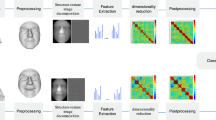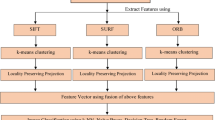Abstract
Recently, the ear biometric has received much attention for human recognition due to its unique shape and rich local features. However, extracting discriminative features from ear images is a crucial task in presence of illumination changes, low contrast, noise, and pose variations. With the aim of neutralizing the effect of these factors, this paper proposes an automatic enhancement technique using meta-heuristic optimization to enhance the ear images. Here, we modified a recent and simple yet meta-heuristic optimization technique known as Jaya algorithm by introducing a mutation operator to enhance the ear images in few iterations and the proposed approach is named as enhanced Jaya algorithm. Then, we employed a pose-invariant local feature extractor, SURF to extract local features. Finally, the k-NN classifier has used to evaluate the rate of correct identification. Extensive experiments are conducted on four standard datasets and the performance evaluation is carried out by qualitative and quantitative measures. Experimental results clearly indicate the proposed enhancement approach is competitive as compared to two classical methods HE, CLAHE, and two meta-heuristic algorithms PSO and DE-based image enhancement techniques.












Similar content being viewed by others
References
Abate AF, Nappi M, Riccio D, Ricciardi S (2006) Ear recognition by means of a rotation invariant descriptor. In: 18th International conference on pattern recognition, ICPR 2006, vol 4, IEEE, pp 437–440
Badrinath G, Gupta P (2009) Feature level fused ear biometric system. In: Seventh international conference on advances in pattern recognition, ICAPR’09, IEEE, pp 197–200
Basit A, Shoaib M (2014) A human ear recognition method using nonlinear curvelet feature subspace. Int J Comput Math 91(3):616–624
Bay H, Ess A, Tuytelaars T, Van Gool L (2008) Speeded-up robust features (surf). Comput Vis Image Underst 110(3):346–359
Benzaoui A, Hadid A, Boukrouche A (2014) Ear biometric recognition using local texture descriptors. J Electron Imaging 23(5):053008
Burge M, Burger W (2000) Ear biometrics in computer vision. In: 5th IEEE international conference on pattern recognition (ICPR)
Bustard JD, Nixon MS (2010) Toward unconstrained ear recognition from two-dimensional images. IEEE Trans Syst Man Cybern Part A Syst Hum 40(3):486–494
Chen Y, Zhang Y, Lu HM, Chen XQ, Li JW, Wang SH (2018) Wavelet energy entropy and linear regression classifier for detecting abnormal breasts. Multimed Tools Appl 77(3):3813–3832
Choraś M (2005) Ear biometrics based on geometrical feature extraction. Electron Lett Comput Vis Image Anal 5(3):84–95
Damer N, Führer B (2012) Ear recognition using multi-scale histogram of oriented gradients. In: 2012 Eighth international conference on intelligent information hiding and multimedia signal processing (IIH-MSP), IEEE, pp 21–24
Das S, Suganthan PN (2011) Differential evolution: a survey of the state-of-the-art. IEEE Trans Evolut Comput 15(1):4–31
Dhal KG, Ray S, Das A, Das S (2018) A survey on nature-inspired optimization algorithms and their application in image enhancement domain. Arch Comput Methods Eng 26(5):1607–1638
Dodge S, Mounsef J, Karam L (2018) Unconstrained ear recognition using deep neural networks. IET Biom 7(3):207–214
Elbes M, Alzubi S, Kanan T, Al-Fuqaha A, Hawashin B (2019) A survey on particle swarm optimization with emphasis on engineering and network applications. Evolut Intell 12(2):113–129
Emeršič Ž, Križaj J, Štruc V, Peer P (2019) Deep ear recognition pipeline. In: Recent advances in computer vision, Springer, New York, pp 333–362
Emeršič Ž, Štruc V, Peer P (2017) Ear recognition: more than a survey. Neurocomputing 255:26–39
Emeršič Ž, Gabriel LL, Štruc V, Peer P (2018) Convolutional encoder-decoder networks for pixel-wise ear detection and segmentation. IET Biom 7(3):175–184
Gorai A, Ghosh A (2009) Gray-level image enhancement by particle swarm optimization. In: 2009 World congress on nature and biologically inspired computing (NaBIC), IEEE, pp 72–77
Guo Y, Xu Z (2008) Ear recognition using a new local matching approach. In: 15th IEEE International conference on image processing, ICIP 2008, IEEE, pp 289–292
Hurley DJ, Nixon MS, Carter JN (2005) Force field feature extraction for ear biometrics. Comput Vis Image Underst 98(3):491–512
Iannarelli A (1989) Ear identification. Paramont Publishing, Hyderabad
Ibrahim MI, Nixon MS, Mahmoodi S (2010) Shaped wavelets for curvilinear structures for ear biometrics. In: Advances in visual computing, Springer, New York, pp 499–508
IIT Delhi Ear Database Version 1. http://web.iitd.ac.in/~biometrics/Database_Ear.htm
Islam SM, Bennamoun M, Davies R (2008) Fast and fully automatic ear detection using cascaded adaboost. In: IEEE workshop on applications of computer vision, WACV 2008, IEEE, pp 1–6
Kaiqi H, Zhenyang W, Qiao W (2005) Image enhancement based on the statistics of visual representation. Image Vis Comput 23(1):51–57
Kisku DR, Mehrotra H, Gupta P, Sing JK (2009) Sift-based ear recognition by fusion of detected keypoints from color similarity slice regions. In: International conference on advances in computational tools for engineering applications, ACTEA’09, IEEE, pp 380–385
Kumar A, Zhang D (2007) Ear authentication using log-gabor wavelets. In: International society for optics and photonics, defense and security symposium, pp 65390A–65390A
Mirjalili S (2019) Particle swarm optimisation. In: Evolutionary algorithms and neural networks, Springer, New York, pp 15–31
Nayak DR, Dash R, Majhi B (2018) Development of pathological brain detection system using jaya optimized improved extreme learning machine and orthogonal ripplet-ii transform. Multimed Tools Appl 77(17):22705–22733
Pflug A, Paul PN, Busch C (2014) A comparative study on texture and surface descriptors for ear biometrics. In: 2014 International Carnahan conference on security technology (ICCST), IEEE, pp 1–6
Prakash S, Gupta P (2012) An efficient ear localization technique. Image Vis Comput 30(1):38–50
Prakash S, Gupta P (2013) An efficient ear recognition technique invariant to illumination and pose. Telecommun Syst 52(3):1435–1448
Prakash S, Jayaraman U, Gupta P (2009) A skin-color and template based technique for automatic ear detection. In: Seventh international conference on advances in pattern recognition, ICAPR’09, IEEE, pp 213–216
Prakash S, Jayaraman U, Gupta P (2009) Ear localization using hierarchical clustering. In: International society for optics and photonics SPIE defense, security, and sensing, pp 730620–730620
Rao R (2016) Jaya: a simple and new optimization algorithm for solving constrained and unconstrained optimization problems. Int J Ind Eng Comput 7(1):19–34
Reza AM (2004) Realization of the contrast limited adaptive histogram equalization (clahe) for real-time image enhancement. J VLSI Sig Proces Syst Sig Image Video Technol 38(1):35–44
Sana A, Gupta P, Purkait R (2007) Ear biometrics: a new approach. Adv Pattern Recognit pp 46–50
Sarangi PP, Mishra B, Dehuri S (2017) Ear recognition using pyramid histogram of orientation gradients. In: 2017 4th International conference on signal processing and integrated networks (SPIN), IEEE, pp 590–595
Sarangi PP, Panda M, Mishra BP, Dehuri S (2016) An automated ear localization technique based on modified hausdorff distance. In: Proceedings of international conference on computer vision and image processing, Springer, New York, pp 229–240
Sarangi PP, Mishra BSP, Dehuri S (2018) Fusion of PHOG and LDP local descriptors for kernel-based ear biometric recognition. Multimed Tools Appl 78(8):9595–9623
Sarangi P, Mishra B, Majhi B, Dehuri S (2014) Gray-level image enhancement using differential evolution optimization algorithm. In: 2014 International conference on signal processing and integrated networks (SPIN), IEEE, pp 95–100
Solomon C, Breckon T (2011) Fundamentals of digital image processing: a practical approach with examples in matlab. Wiley, Hoboken
Storn R, Price K (1997) Differential evolution-a simple and efficient heuristic for global optimization over continuous spaces. J Glob Optim 11(4):341–359
Tiwari V, Jain S (2019) An optimal feature selection method for histopathology tissue image classification using adaptive Jaya algorithm. Evolut Intell 1–14
University of Notre Dame Ear Database, Collection E and Collection J2. http://www.nd.edu/~cvrl/CVRL/DataSets.html
Victor B, Bowyer K, Sarka S (2002) An evaluation of face and ear biometrics. In: 16th International conference and proceedings on pattern recognition, vol 1, IEEE, pp 429–432
Wang S, Rao RV, Chen P, Zhang Y, Liu A, Wei L (2017) Abnormal breast detection in mammogram images by feed-forward neural network trained by Jaya algorithm. Fundam Inf 151(1–4):191–211
Wang SH, Phillips P, Dong ZC, Zhang YD (2018) Intelligent facial emotion recognition based on stationary wavelet entropy and Jaya algorithm. Neurocomputing 272:668–676
Xie Z, Mu Z (2008) Ear recognition using LLE and IDLLE algorithm. In: 19th International conference on pattern recognition, ICPR 2008, IEEE, pp 1–4
Yuan L, Li C, Mu Z (2012) Ear recognition under partial occlusion based on sparse representation. In: 2012 International conference on system science and engineering (ICSSE), IEEE, pp 349–352
Yuan L, Mu ZC (2007) Ear detection based on skin-color and contour information. In: 2007 International conference on machine learning and cybernetics, vol 4, IEEE, pp 2213–2217
Zhang HJ, Mu ZC, Qu W, Liu LM, Zhang CY (2005) A novel approach for ear recognition based on ICA and RBF network. In: Proceedings of 2005 international conference on machine learning and cybernetics, vol 7, IEEE, pp 4511–4515
Zhang Y, Mu Z, Yuan L, Yu C (2018) Ear verification under uncontrolled conditions with convolutional neural networks. IET Biom 7(3):185–198
Author information
Authors and Affiliations
Corresponding author
Additional information
Publisher's Note
Springer Nature remains neutral with regard to jurisdictional claims in published maps and institutional affiliations.
Rights and permissions
About this article
Cite this article
Sarangi, P.P., Mishra, B.S.P., Dehuri, S. et al. An evaluation of ear biometric system based on enhanced Jaya algorithm and SURF descriptors. Evol. Intel. 13, 443–461 (2020). https://doi.org/10.1007/s12065-019-00311-9
Received:
Revised:
Accepted:
Published:
Issue Date:
DOI: https://doi.org/10.1007/s12065-019-00311-9




